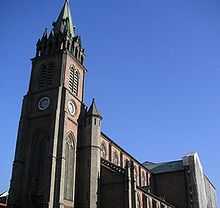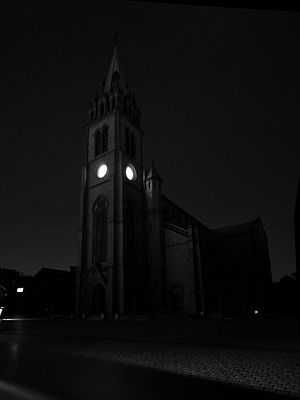Myeongdong Cathedral
|
Cathedral Church of the Virgin Mary of the Immaculate Conception Myeongdong Cathedral | |
 | |
| Korean name | |
|---|---|
| Hangul | 명동대성당 |
| Hanja | 明洞大聖堂 |
| Revised Romanization | Myeongdong Daeseongdang |
| McCune–Reischauer | Myŏngdong Taesŏngdang |
The Cathedral Church of the Virgin Mary of the Immaculate Conception also known as Myeongdong Cathedral, is a prominent Latin-rite Roman Catholic church located in the Myeongdong neighborhood of Jung-gu, Seoul, South Korea. It is the seat of the Archbishop of Seoul, Andrew Yeom Soo-jung, the highest Catholic prelate in the country.
Dedicated in honor of Our Lady of the Immaculate Conception, the principal patroness of Korea and the Korean people, the cathedral is a community landmark and a notable symbol of Catholicism in Korea. The cathedral church is one of the earliest and most notable examples of Gothic Revival architecture in Korea.
Structural details
The original church was constructed with twenty types of locally fired red and gray bricks. The main building rises to 23m high, while the steeple, which contains a clock, rises to 45m. It was designated National Historic Site #258 on November 22, 1977.[1]
The interior of the church is ornately decorated with religious artwork. Stained glass windows depict the Nativity of Jesus and Adoration of the Magi, Jesus with the Twelve Apostles, and the Fifteen Mysteries of the Rosary. The windows were restored to their original condition in 1982 by artist Lee Nam-gyu.
The crypt of the cathedral lies directly beneath the main altar. The crypt contains the relics of nine Korean Church martyrs. Two of the martyrs' identities are unknown. The remaining five are Bishop Laurent-Joseph-Marius Imbert (the second Bishop of the Church in Korea), Father Maubant, Father Chastan Kim Sung-woo Antonio, and Choi Gunghwan Francesco. A special pilgrimage Holy Mass takes place every weekday morning in the Crypt Chapel.
On the 50th anniversary of the consecration of the church in 1948, a French statue of Our Lady of Lourdes bearing the title “the Immaculate Conception” was erected behind the church property. On August 27, 1960, Archbishop Paul Roh Ki-nam consecrated the grotto and dedicated it towards Korean national peace.
History
Christianity was heavily persecuted in Joseon-era Korea. Still, interest in it grew as an academic novelty, notably among members of the Silhak (실학; "practical learning") school, attracted to what they saw as its egalitarian values.[2] Catholicism gained ground as a belief in the 19th century through the work of French missionaries, the persecutions of whom led to an 1866 French expedition.
After the Joseon dynasty concluded a commercial treaty with United States in 1882, Jean M. Blanc, Bishop of Korea, sought land to build a mission. Under the name Kim Gamilo, he acquired a vacant lot on Jonghyeon (Chong-Hyen), meaning "Bell Hill"; due to its proximity to a temple, Koreans had declined to build there.[3] An education center was constructed, and plans to build a church placed under the supervision of French priest Eugene Coste at the conclusion of a commercial treaty between Korea and France in 1887.[1]
Emperor Gojong held the ceremony of laying the first stone on August 5, 1892. Construction cost around US$60,000,[3] supported by the Paris Foreign Missions Society. Because of the First Sino-Japanese War, however, and the subsequent death of Fr. Coste, the inauguration of the cathedral was postponed for several years. On May 29, 1898, it was finally dedicated and consecrated to the Immaculate Conception of the Blessed Virgin.[4] At its construction, it was the largest building in Seoul.[3]
In 1900, the relics of the Korean Martyrs who died in the 1866 persecution were moved to its crypt from the seminary in Yongsan-gu.
The Roman Catholic clergy were among the leading critics of South Korea's military rule in the 1970s and 1980s, and Myeongdong Cathedral became a center of Minjung political and labor protest as well as a sanctuary for the protesters;[5] indeed, it was nicknamed the "Mecca" of pro-democracy activists.[6] Catholic and future President Kim Dae-jung held a rally at the cathedral in 1976 to demand the resignation of President Park Chung Hee, and some 600 student-led protesters staged a hunger strike inside in 1987 after the torture and death of university student Park Jong-chol.[7]
The cathedral remains a popular spot for protesters, due to the government's previous disinclination to arrest protesters inside church property. In 2000, the cathedral attempted to officially ban protesters who did not have prior approval after a protest of telecommunications labor unions beat female churchgoers and vandalized church property.[7]
Patronage of the church

Amidst Korean suspicion and persecution of Christianity at the time, Pope Gregory XVI established the first Apostolic Vicariate in Seoul, Korea in 1831. The community initially survived without the help of foreign Catholic priests, who were unable to come due to anti-Catholic persecutions earlier that year.[8][9] According to Cardinal Nicolas Cheong Jin-suk, in 1841, Pope Gregory XVI solemnly dedicated the Catholic Church in Korea to the Blessed Virgin Mary under the title Immaculate Virgin.[10] Pope Gregory XVI officially declared the Immaculate Conception as the Patroness of Korea and the Korean people in 1864[11] The church became a planned structural building from this patronage invoked by the pontiff thirty years later in 1894.[12][13]
On May 6, 1984, Pope John Paul II reaffirmed the Blessed Virgin as the patroness of the Cathedral and the Republic of Korea.[14] In his 1984 Apostolic Letter, Pope John Paul II noted that Bishop Imbert (Embert) Bum first consecrated Korea to the Immaculate Conception in 1837, followed by Bishop Jean Joseph Ferréol in 1846 along with Saint Joseph as its co-patron.[13][15] According to the papal brief, a similar re-dedication of patronage to the Immaculate Conception was invoked on by the French Bishop Gustave Charles Mutel (1854–1933) on May 29, 1898.
Previous names
The church was originally called the Jonghyeon Cathedral (종현성당, 鐘峴聖堂), and later as simply The Catholic Church (천주교회 天主敎會) during the Japanese occupation. After the liberation years of Korea from colonial rule, the name was later changed to the Cathedral Church of the Virgin Mary of the Immaculate Conception and was colloquially referred to by its congregants as the Myeongdong Cathedral.
References
- ↑ 1.0 1.1 Cultural Heritage Administration (Republic of Korea). "Heritage Information: Myeongdongseongdang". Retrieved 2008-05-16.
- ↑ Seoul International Publishing House (1983). Focus on Korea, Korean History. Seoul. pp. 7–8.
- ↑ 3.0 3.1 3.2 F. Ohlinger, H. G. Appenzeller, George Heber Jones (January 1898), The Korean repository 5, p. 239
- ↑ "History of Myeong Dong Cathedral". www.mdsd.or.kr. Retrieved 2008-05-16.
- ↑ Conde, Carlos H. (April 3, 2005). "Asians Pay Tribute to the Pope". International Herald Tribune.
- ↑ The Associated Press (March 7, 2008). "SKorean priests lead campaign against 'economic dictator' Samsung".
- ↑ 7.0 7.1 Lee, Dong-min (March 22, 2002). "Myeongdong Cathedral Fighting Image of Protest Haven". Korea Herald.
- ↑ http://www.questia.com/googleScholar.qst?docId=5002355967
- ↑ Brother Zechariah Foreman, O.P. (May 4, 2004), True Doctrine in the Hermit Kingdom: A Brief Survey of the Catholic Church in Korea
- ↑ Both North and South consecrated to the Immaculate Virgin, says Bishop of Seoul
- ↑ http://www.catholic.org/saints/patron.php?letter=K Missing or empty
|title=(help) - ↑ Phoenix TV documentary of the Myeongdong Cathedral
- ↑ 13.0 13.1 http://www.marys-touch.com/newspapers/2009.pdf
- ↑ Pope John Paul II (6 May 1984), Address of Pope John Paul II Before Declaring the Act of Entrustment of Korea to Mary
- ↑ http://www.namyangmaria.org/en/korean_catholic.html
External links
- (Korean) Myeongdong Cathedral Official Website (Korean)
- (English) Myeongdong Cathedral English information, providing history, architectural and decorative highlights, service schedule, and directions
Coordinates: 37°34′01″N 126°58′34″E / 37.56694°N 126.97611°E